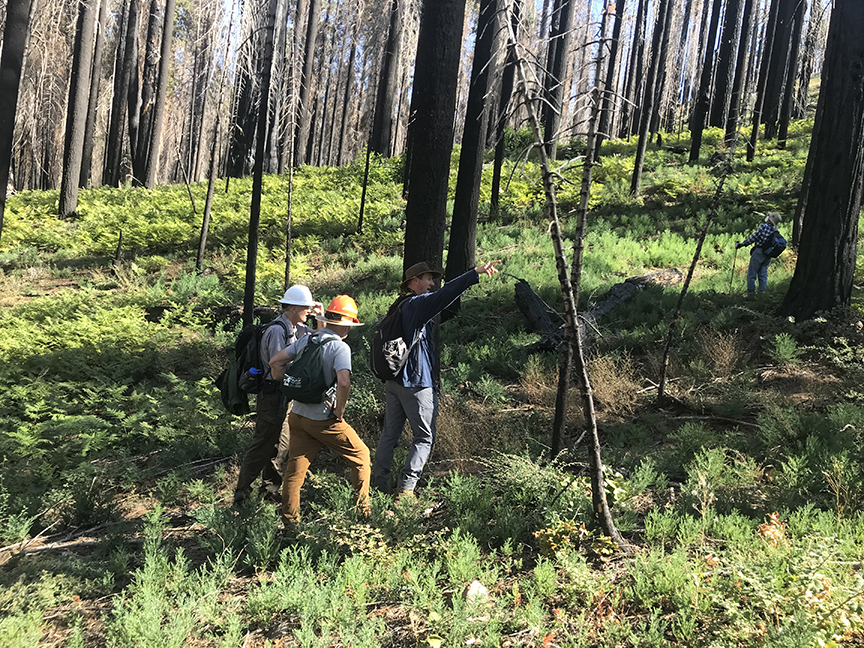WW sues NPS to protect Wilderness in Sequoia and Kings Canyon
 On September 25, 2023, Wilderness Watch, Sequoia ForestKeeper, and Tule River Conservancy filed a lawsuit against the National Park Service (NPS), challenging the agency’s unlawful decision to implement extensive and motorized tree cutting and burning across thousands of acres of designated Wilderness within Sequoia and Kings Canyon National Parks. On November 17, 2023, the original complaint was amended to also challenge the NPS' unlawful decision to implement extensive tree planting across acres of designated Wilderness within Sequoia and Kings Canyon National Parks. At that time, the John Muir Project was also added as a plaintiff group.
On September 25, 2023, Wilderness Watch, Sequoia ForestKeeper, and Tule River Conservancy filed a lawsuit against the National Park Service (NPS), challenging the agency’s unlawful decision to implement extensive and motorized tree cutting and burning across thousands of acres of designated Wilderness within Sequoia and Kings Canyon National Parks. On November 17, 2023, the original complaint was amended to also challenge the NPS' unlawful decision to implement extensive tree planting across acres of designated Wilderness within Sequoia and Kings Canyon National Parks. At that time, the John Muir Project was also added as a plaintiff group.
NPS authorized the fuel reduction and tree planting project through an October 2022 decision memorandum that was styled as constituting “alternative arrangements” for compliance with the National Environmental Policy Act (NEPA). However, the agency short-circuited NEPA’s requirements for public involvement and environmental review. Furthermore, the thousands of acres of tree cutting with chainsaws and other motorized activity directly contravenes earlier plans implemented by NPS, which acknowledged the ways in which such activity is unlawful within Wilderness.
The Wilderness Act prohibits NPS from intentionally altering natural processes in designated Wilderness areas and specifically prohibits the use of motor vehicles and motorized equipment (helicopters and chainsaws) by which the agency plans to implement its tree cutting, burning project, and planting project. Nonetheless, NPS made the now-challenged decision to intensively reconfigure the forest structure in and around sequoia groves deep within the Wilderness areas.
NPS decided to forego the environmental analysis and public engagement process typically required by NEPA. Instead, the agency fashioned its project authorization as “emergency” activities, citing certain provisions applicable to NEPA that allow agencies to act quickly in the immediacy of discrete emergencies and to thus adjust the mode with which they then satisfy their NEPA obligations.
The Park Service's approach to the “fuels reduction” and tree planting in Sequoia and Kings Canyon National Parks does not fit the mold of a qualified emergency. Instead, the agency’s project spans tens of thousands of acres of landscape-scale modifications, with planning that was framed prospectively to be implemented over an indefinite period of years. Our legal challenge focuses on the detriment to the public in allowing federal agencies to shield large-scale and controversial projects from public involvement under the guise of “emergency.”
Additional Resources
- Amended complaint (11/17/2023)
- Press release from Wilderness Watch and our partners when lawsuit was filed (9/25/2023)
- Copy of the complaint (9/25/2023)
- FAQ: Sequoia and Kings Canyon National Parks tree cutting and burning project in Wilderness lawsuit (9/25/2023)
News Articles
- Why environmentalists are suing the National Park Service to prevent it from planting trees (CNN)
- NPS wants to plant sequoias. Environmentalists sue, say there’s no need to butt in (Los Angeles Times)
- Enviros sue Park Service over planting sequoias (Wildfire Today)
- California environmentalists sue to stop replanting of sequoia groves (San Francisco Chronicle)
- Conservationists sue to stop feds from razing trees, burning land in two California parks (Courthouse News Service)
- Should the feds cut trees in California’s wilderness to reduce fire risk? New lawsuit says no (San Francisco Chronicle)
- Park Service should refrain from planting sequoia seedlings and let nature do its job (Sacramento Bee)
- Team of researchers find wildfire is future to saving California's giant sequoias (CBS)
Photos:
Top—The National Park Service plans to cut most of the trees surrounding these Giant Sequoias in the Lost Grove within a Sequoia and Kings Canyon National Parks Wilderness area. Photo by René Voss.
Bottom—Abundant natural regeneration of giant sequoia seedlings in a large high-intensity fire patch in the Redwood Mountain Grove within the Sequoia-Kings Canyon Wilderness, one of the groves the National Park Service claims is not regenerating and in need of artificial plantings. Photo taken September 29, 2023 by Doug Bevington.
Contact Us
Wilderness Watch
P.O. Box 9175
Missoula, MT 59807
P: 406.542.2048
Press Inquiries: 406.542.2048 x2
E: wild@wildernesswatch.org
Minneapolis, MN Office
2833 43rd Avenue South
Minneapolis, MN 55406
P: 612.201.9266
Moscow, ID Office
P.O. Box 9765
Moscow, ID 83843

